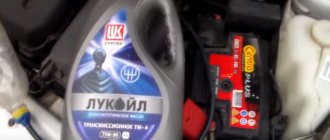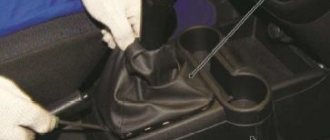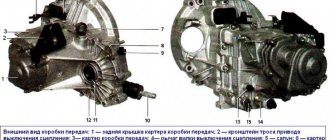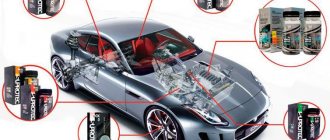Changing the oil is one of the most common and mandatory maintenance jobs for any car. At the same time, having studied the instructions well, you can easily cope on your own and save on car service services. To do this, we will consider in detail which oil is best to pour when replacing a Chevrolet Niva, not only into the box, but also into the transfer case, as well as axles.
How to choose oil for the Niva Chevrolet gearbox, transfer case and axles.
Transmission oil tolerances for Niva Chevrolet
An important aspect when choosing a lubricant is viscosity. Based on this parameter, it is determined under what temperature conditions the car will operate. In practice, most car owners fill the Chevrolet Niva engine with oils with a viscosity of 10 - 40, both in summer and winter. If you adhere to the principle of changing oil according to the season, then:
- with the onset of cold weather, fill in transmission fluid with a viscosity of 5 - 40;
- in the warm season, use lubricant 10 - 40.
Some people use very thin oils 0 – 40, but they cost much more and won’t make much of a difference. If the car engine does not have hydraulic compensators, you can use 10 - 40 regardless of the season, and in the case of hydraulic compensators, fill in 5 - 40.
The procedure for changing the oil in a Niva transfer case yourself
If, as a result of another check of the level or quality of the transmission fluid in the transfer case, it turns out that it is time to replace it (symptoms indicating the need to perform such a procedure may be not only a very dark color of the oil with the inclusion of solid particles, but also the appearance of noise when turning on the transfer case or during its operation), you can perform such a replacement on your own.
To do this, you will need a 19 and 12 hex wrench, a liter container for used lubricant and some rags. It will also be necessary to provide access to the car from the bottom, for which you can use a lift, an overpass or an inspection hole.
Immediately before replacement, you should warm up the car (drive it for about 10 kilometers). Procedure for changing the oil in the Niva transfer case:
- We place a prepared container under the drain hole (preferably with a wide neck to avoid spilling liquid);
- Using a 19mm hex key, unscrew the drain plug, being careful not to get dirty or burn yourself;
- thoroughly clean the plug itself and the magnets installed on it from all dirt and metal shavings;
- when the transmission fluid stops dripping, install the plug in its original place, ensuring sufficient, but not excessive tightening force;
- Using a 12mm hex, unscrew the filler plug, using a special technical syringe or funnel with a suitable neck, fill in fresh lubricant until its level reaches the lower edge of the technological hole;
- tighten the plug;
- carefully clean the seat of the filler neck with a rag to remove any oil leaks;
- We repeat the same procedure with respect to the breather located at the transfer case on the side of the propeller shaft (rear).
Note that draining and adding fresh oil is a technically absolutely identical procedure for all modifications of the Niva.
What does the manufacturer recommend?
It is important to remember that it is strictly forbidden to add lubricants of the most common API GL-5 standard to the Chevrolet Niva gearbox. On the one hand, it is better in terms of performance: it performs well at high speeds, high loads and temperatures. On the other hand, it contains sulfur-phosphorus extreme pressure additives, which in high concentrations can disrupt the operation of the Niva manual transmission synchronizers. Most car enthusiasts recommend using transmission fluids of the GL-5 standard for addition to axles and gearboxes.
The transfer case and gearbox should be filled with oil that meets API GL4 or GL4/GL5 quality standards and SAE viscosity 75W-90, 80W-85, 80W-90. Transmission fluid according to API GL5 or GL4/GL5 is intended for gearboxes, front and rear axles. It is better not to use oil with GL4 standard.
Decoding the numbers and abbreviations of transmission oil
Just like motor oil, transmission oil is divided into summer and winter. Thus, the letter W in the viscosity class means the word Winter, this means “Winter”. This type is intended for use in winter, but such oils can also be used in summer. Summer gear oil is used in warm countries where the climate is milder, and in Russia there are more cold months than warm ones. Viscosity classes are determined according to the generally accepted classification of transmission oils (there are a total of 9 viscosity levels in this classification). The numbers here indicate the temperature range at which this substance can be used:
- 75w-90 - operated at temperatures from -40 to +35 °C;
- 80w-85 - at temperatures from -26 to +35 °C;
- 85w-90 - at temperatures from -12 to +35 °C.
Following this classification, transmission oil for Niva-Chevrolet can be easily purchased by any beginner.
The letters API also indicate a generally accepted classification. According to these accepted standards, lubricants are divided into groups. The classification is based on the type of construction and operating conditions. According to this system, oils are designated by numbers from 1 to 5. Here, the higher the number, the more severe conditions the lubricants can be used.
What kind of oil to pour into the gearbox
Time-tested and widespread brands of lubricating fluids for the Chevrolet Niva gearbox:
- Gazpromneft. Relatively inexpensive domestic brand, good quality.
- Eneos. Stably maintains fluidity at temperatures down to -30 degrees.
- Lukoil.
- Castrol. Softens transmission operation and reduces noise.
- TNK. Russian manufacturer of mineral oils. Recommended for use with low mileage and low vehicle use.
- Shell. It is used in sports cars and performs well in Niva. Usually helps with noise in transmission units. Recommended for use during active off-road use.
- Mobil. High quality oils, containing modern anti-wear additives. Copes well with heavy loads in the transmission in any speed range.
Of course, there are other brands of lubricant manufacturers, but you should trust the brands presented. The manufacturer recommends changing the lubricant every 45 thousand kilometers. But it all depends on the conditions and activity of exploitation.
How much oil to fill in Niva
First generation 2121, since 1977
Despite the lightweight monocoque body and structural basis from the VAZ-2106, the Niva has impressive off-road capabilities largely due to its short wheelbase and almost non-existent body overhangs, which ensures high approach and departure angles. The car also has permanent all-wheel drive and is equipped with a transfer gearbox. Under the hood there is a non-alternative 1.7 petrol engine with a power of 81 hp. s., aggregated with a five-speed manual transmission. In 2021, AvtoVAZ improved the car's suspension - installed gas-filled shock absorbers and bearings in the front hubs, and also introduced independent mounting of the front axle gearbox. Since 2021, the car has been officially sold as Lada Niva.
Selection of oil for transfer case
In order to choose the right lubricant for the transfer case, several factors should be taken into account. One of the most important is compatibility with other liquids used. Before purchasing, be sure to check the viscosity of the lubricant. At the same time, it is not at all necessary to purchase products from one manufacturer. It is also not recommended to use lubricants with different chemical compositions so that they do not mix. This is very important if you want to truly improve the performance of your car. Therefore, if you fill a Chevrolet Niva with semi-synthetics, then in the case of the transfer case, purchase a semi-synthetic lubricant.
Manufacturer's requirements
The car manufacturer, taking into account the design features of a particular transmission, puts forward requirements that the oil used by car owners must satisfy. These requirements are always indicated in the service book. On the packaging of any oil, in addition to the product name, there is always a marking with the following information:
The gearboxes of VAZ 2121 all-wheel drive vehicles have a hypoid main pair, which operates at high speeds at low torques and shock loads on the gears. Oils for these domestic machines must belong to the following operational groups:
After studying the service book for the car, you will find the automaker's recommendations for a specific group. Using lower groups of oils in hypoid axles will lead to unpleasant consequences. For example, scuffs may form on the rubbing elements, and this will cause expensive major repairs or replacement of the entire gearbox. First of all, this is due to the fact that oils of low performance groups have lower welding load and scuffing index, that is, they cannot withstand the necessary loads.
Another important indicator that is present in the marking of gear oils is the viscosity class. All oils, including transmission oils, are divided into all-season and seasonal.
What to choose for bridges
In most cases, the oil chosen for axles is the same as for the transfer case. Their full compliance guarantees you high functionality of all components of the transmission during active daily use of the car. Most car enthusiasts agree that you should only buy proven lubricants. These include products from the following brands:
- Castrol;
- Lukoil;
- Liqui Moly;
- Mobil;
- Shell;
- Elf;
- ZIC.
This is a list of the most popular and widely used brands. Their products are used by a huge number of car enthusiasts with different experience levels. When purchasing, be sure to check the compatibility of the viscosity and chemical composition with the oil already used in the gearbox.
How to check and change the oil in the Niva transfer case
The heart of the VAZ 2121 car is the engine. For its proper and long-term operation, good lubrication is required. Typically this is a synthetic or mineral-based motor oil with varying viscosities and a variety of additives that reduce friction between parts and restore rubbing surfaces. In units where lubricating fluid is used, extreme temperature conditions arise, which leads to the appearance of wear products of rubbing parts. They contaminate the base, because of this, over time the liquid may lose its properties, and the unit will need to replace the VAZ 2121 oil.
How, where and what should be poured into the transmission?
In order to properly fill the transmission with lubricant, you need to know the types of oils that are suitable in viscosity for a particular season. Winter types are used not only in winter, but also in summer. In Russia this is most common, since it is more often cold than warm. In order to choose the right and good lubricant, before replacing you need to follow a few tips:
- Before choosing any product from oil companies, you need to review their composition and recommendations for use.
- You should not choose the most expensive lubricant, because replacing the recommended oil with this may negatively affect the operation of the lubrication system.
- Untimely replacement of lubricant is a sure step towards rapid wear of automotive components.
- The greater the mileage of the car, the harsher the operating conditions. This means that the lubricant must be replaced much more often than in almost new cars.
- The oil sensor must be in good working order and the lubricant level must be constant. If for some reason the level drops, then more lubricant must be added.
Changing the oil is quite important for the VAZ Niva SUV. Each type of car requires its own type of lubrication, otherwise problems with the systems may occur. Or, in the worst case scenario, some part may fail.
Car maintenance: adding lubricant
Some types of oils recommended for transmissions in Chevrolet Niva
There is a wide selection of gear oils on the market. The leading brands among them are:
- Lukoil "TM-4 75w-90";
- Castrol "Syntrax Universal Plus 75W-90";
- ExxonMobil "Mobilube 1 SHC 75W-90";
- TNK "Trans KP Super 75W-90";
- Gazpromneft "G-Box GL-4 75W-90";
- Shell "Spirax S4 G 75W-90 (Getriebeoil EP)".
These are proven high-quality lubricants, the only difference being the price. Which one to fill is up to the car enthusiast to choose.











